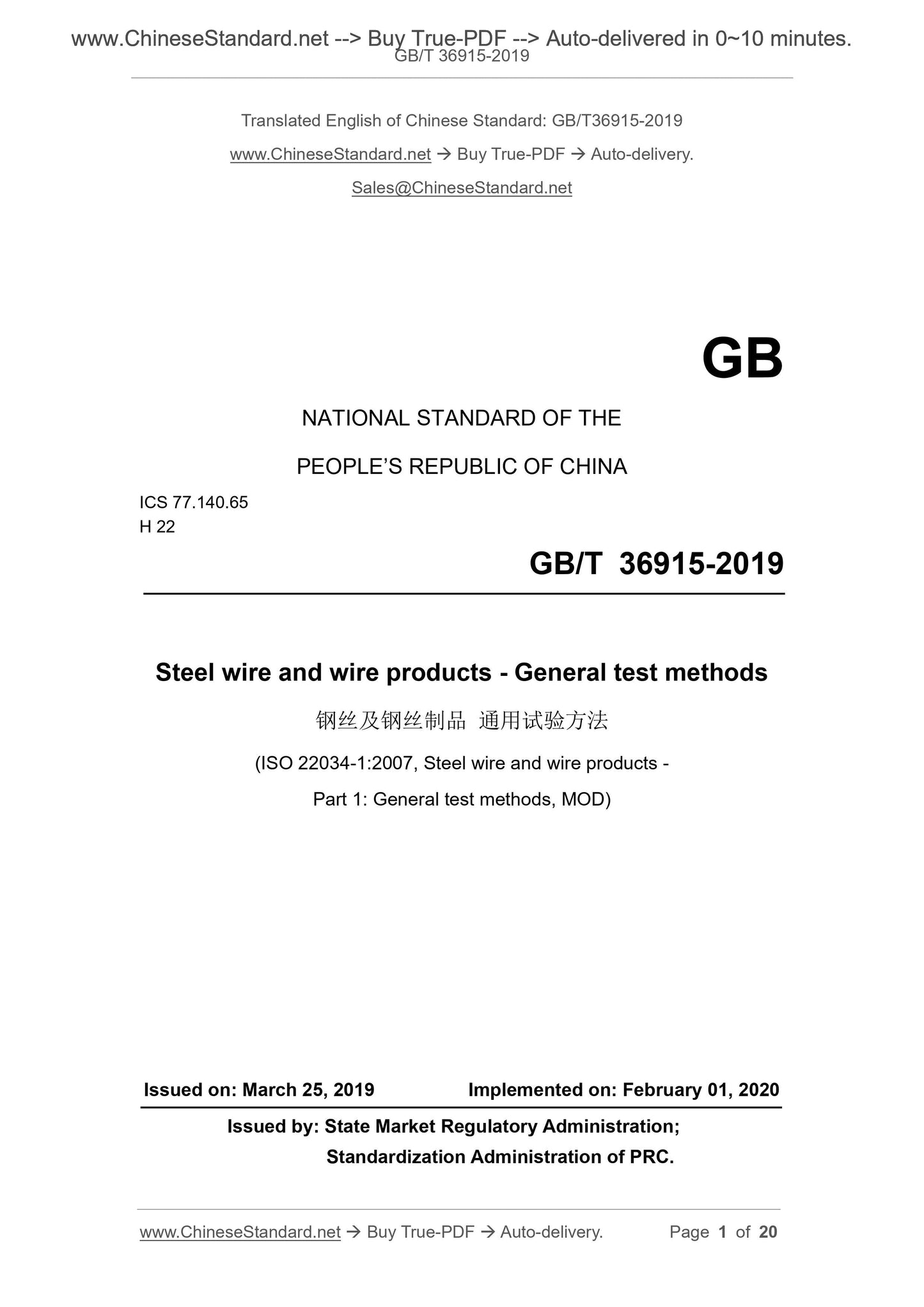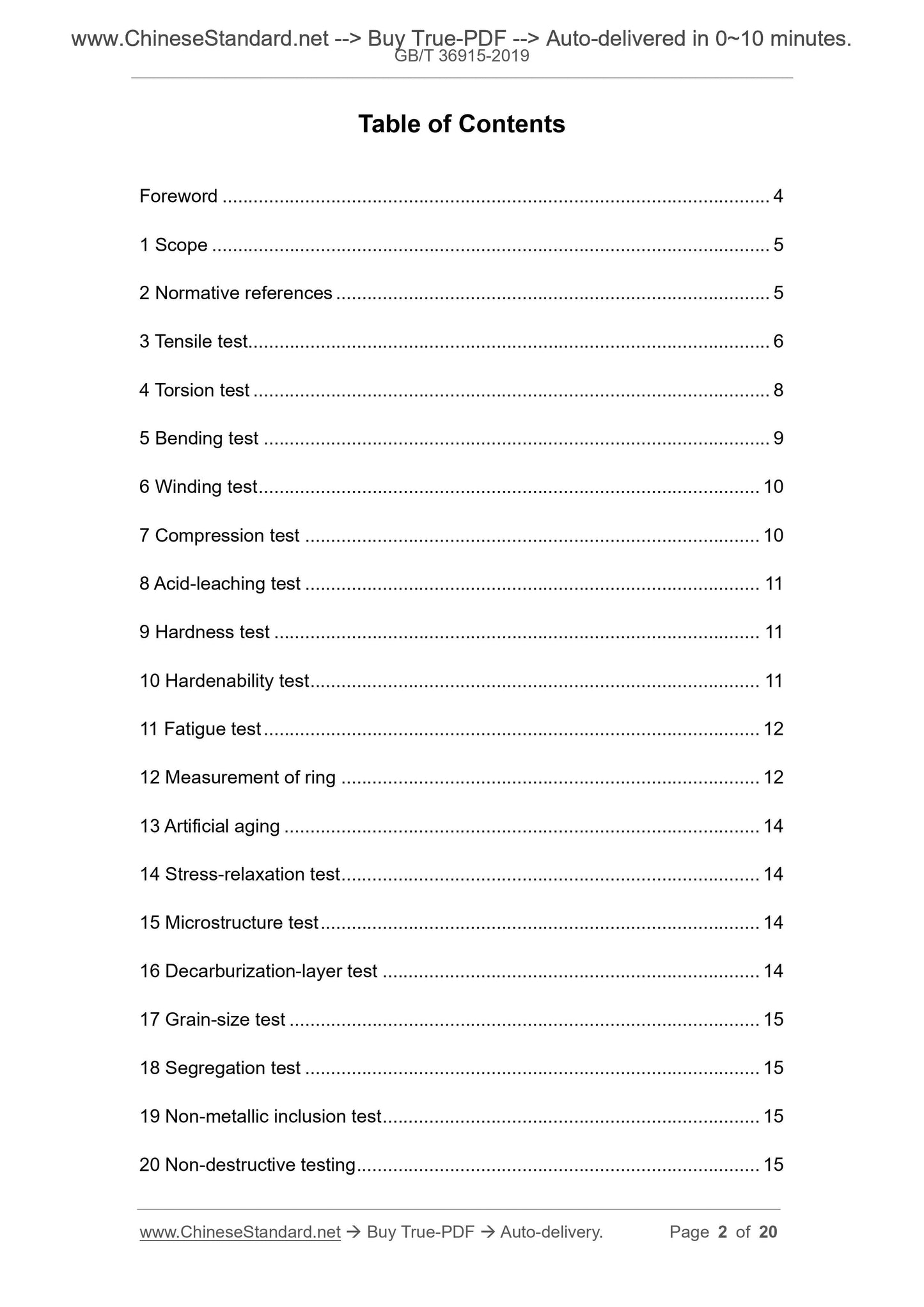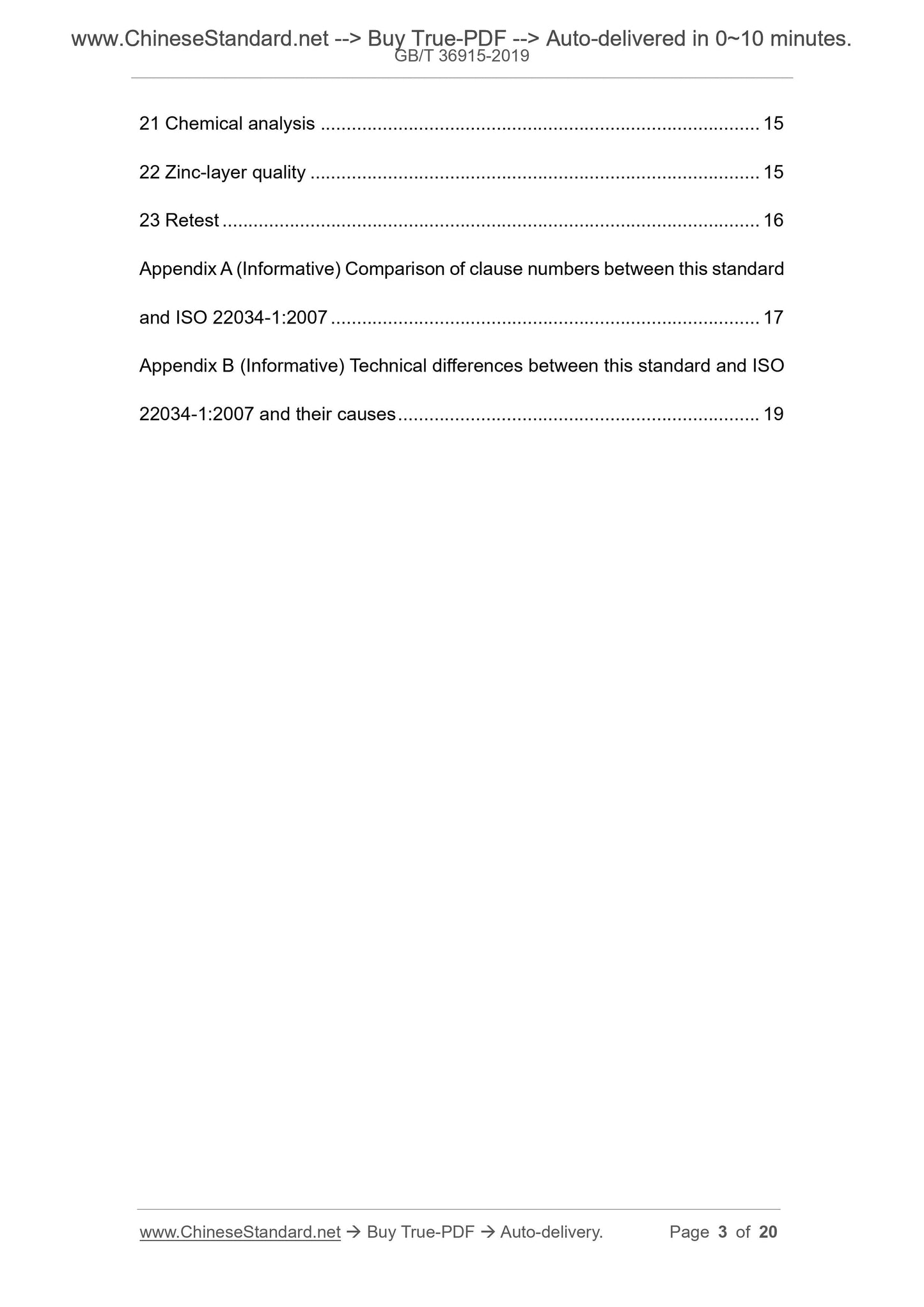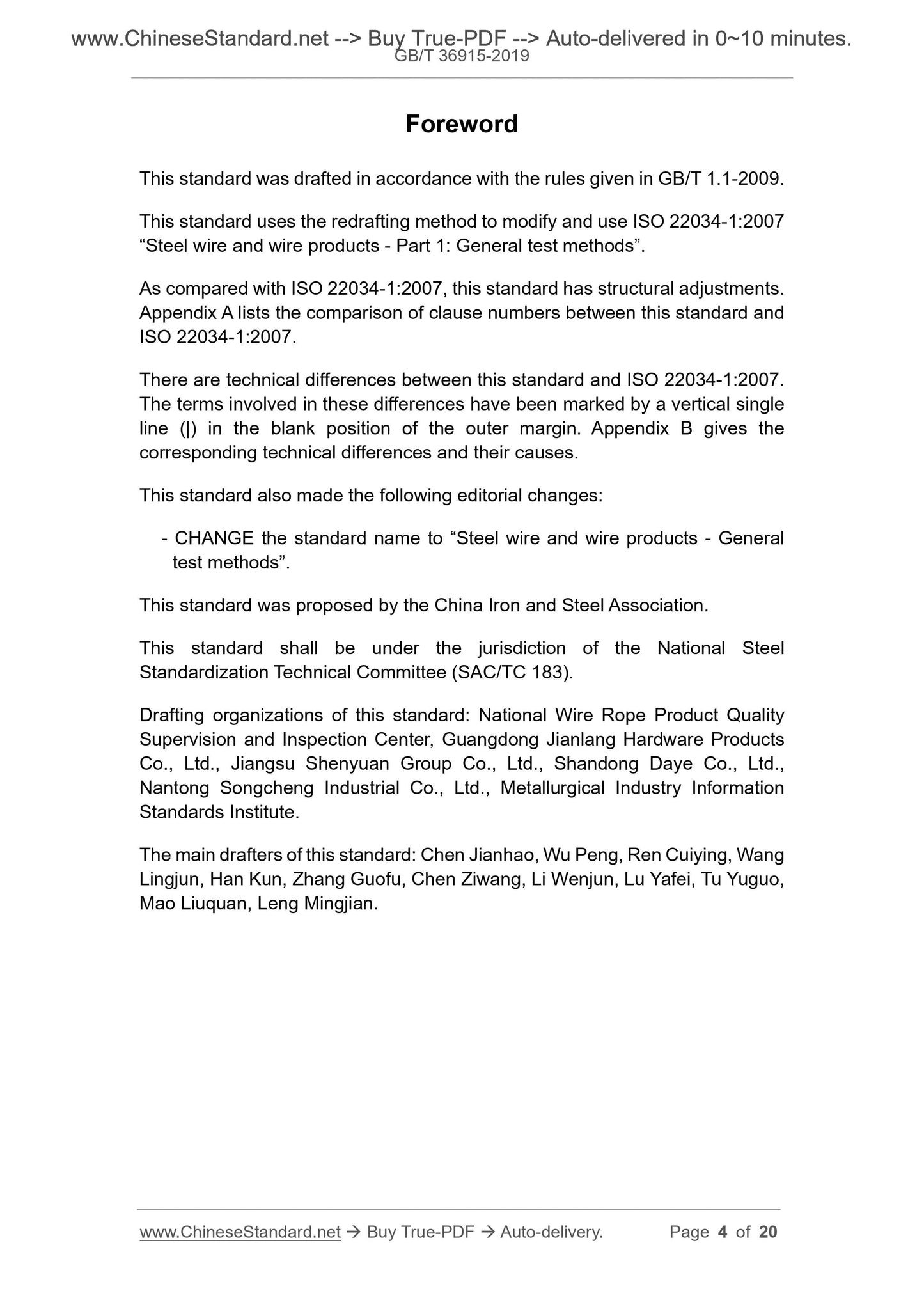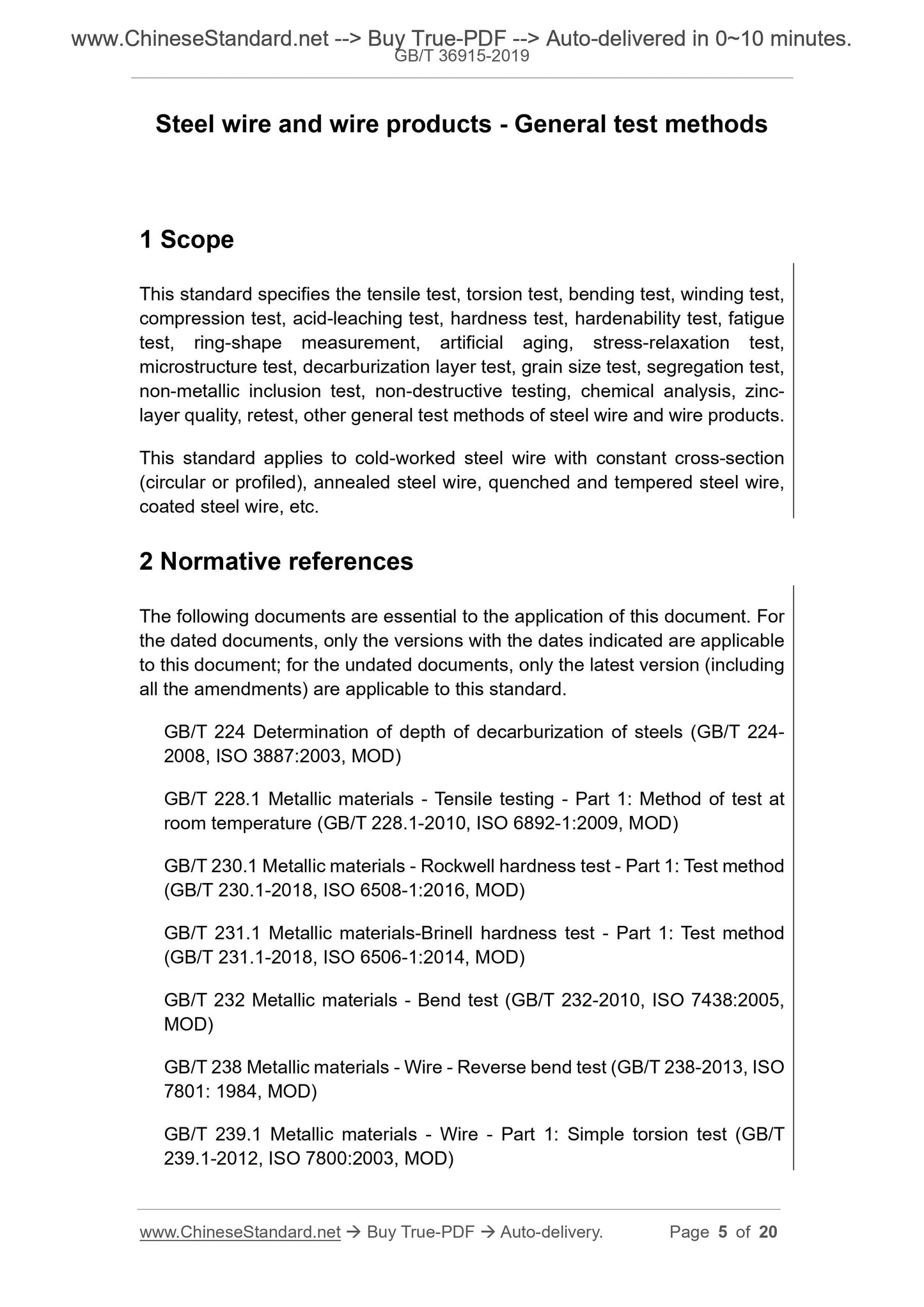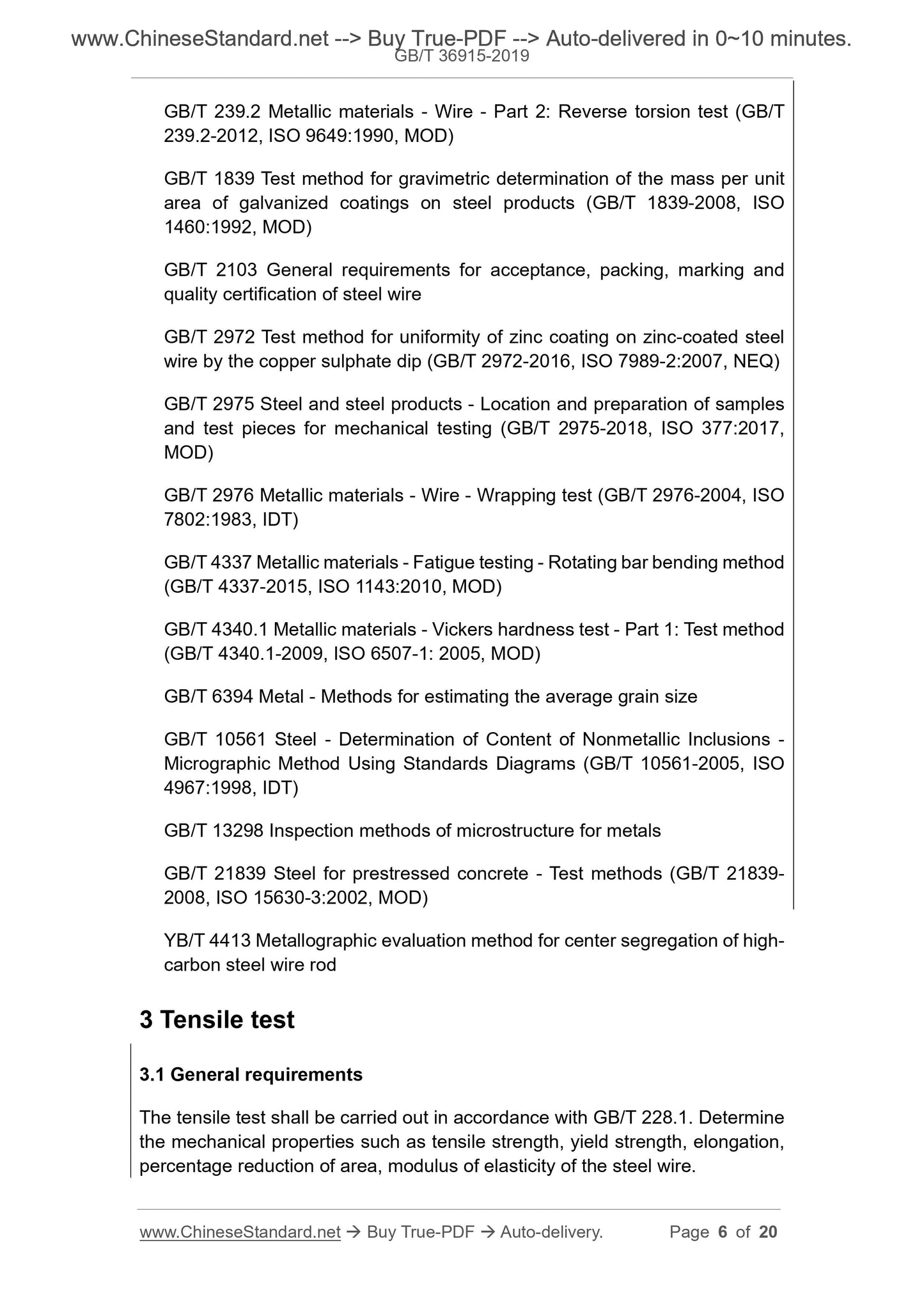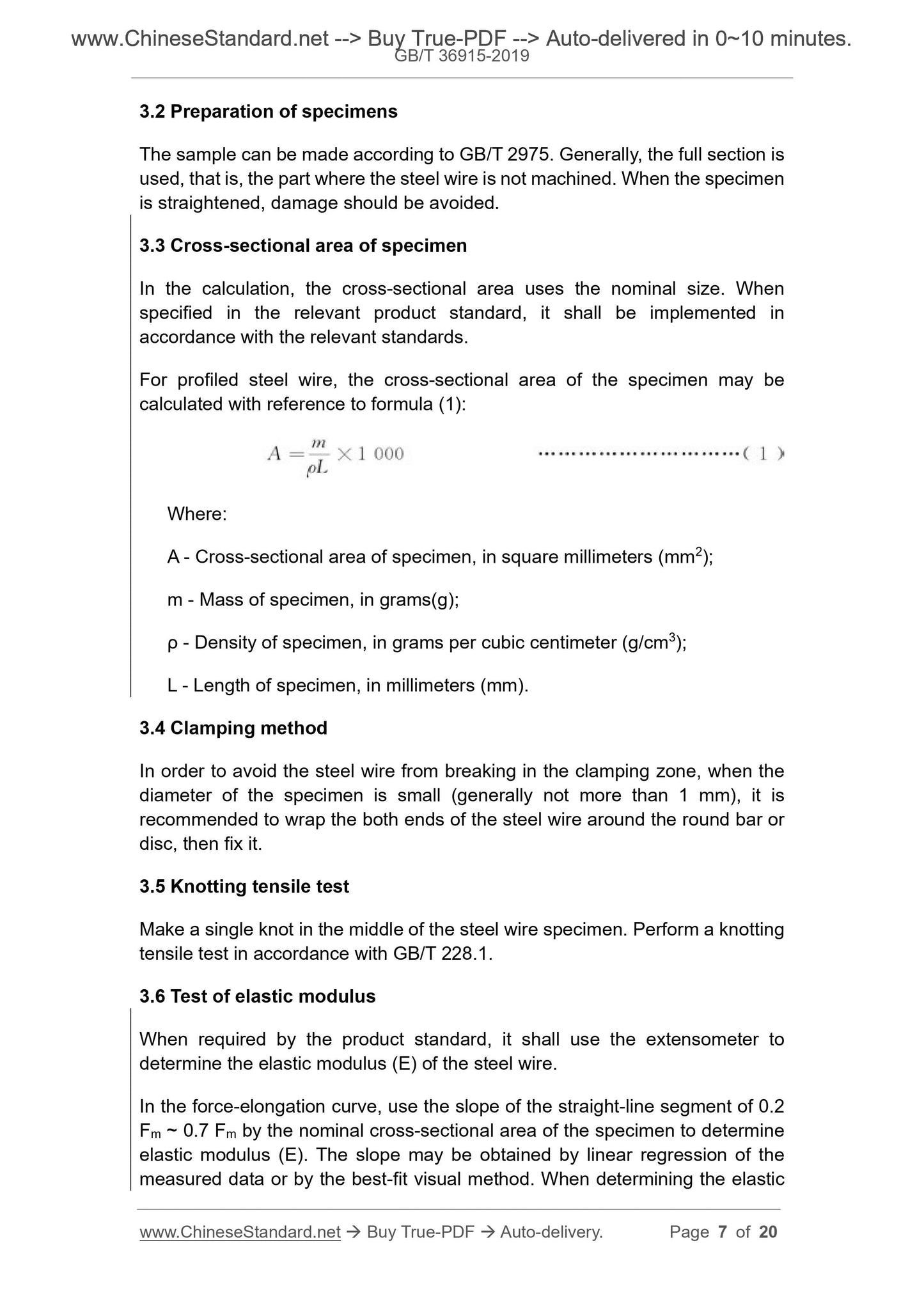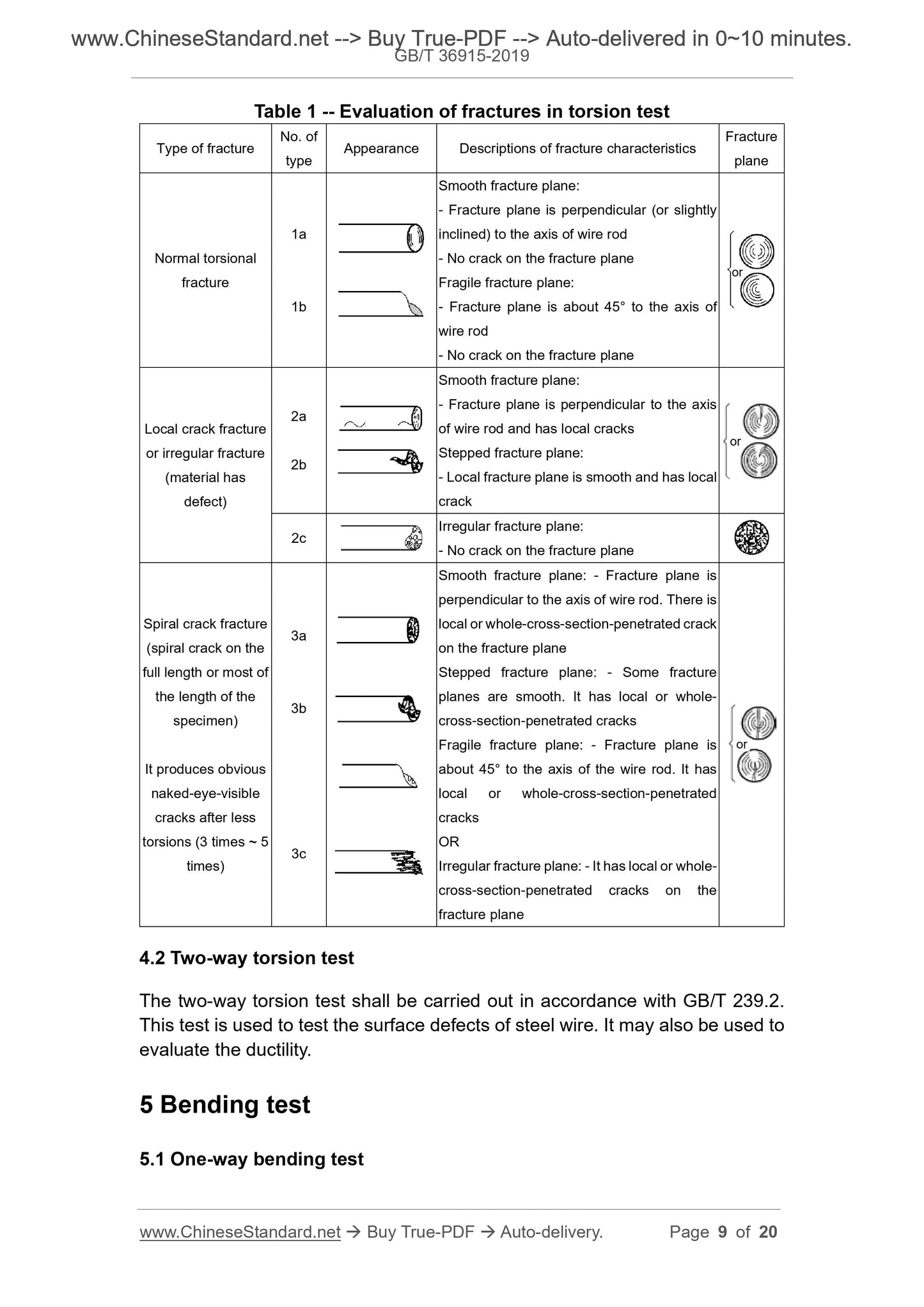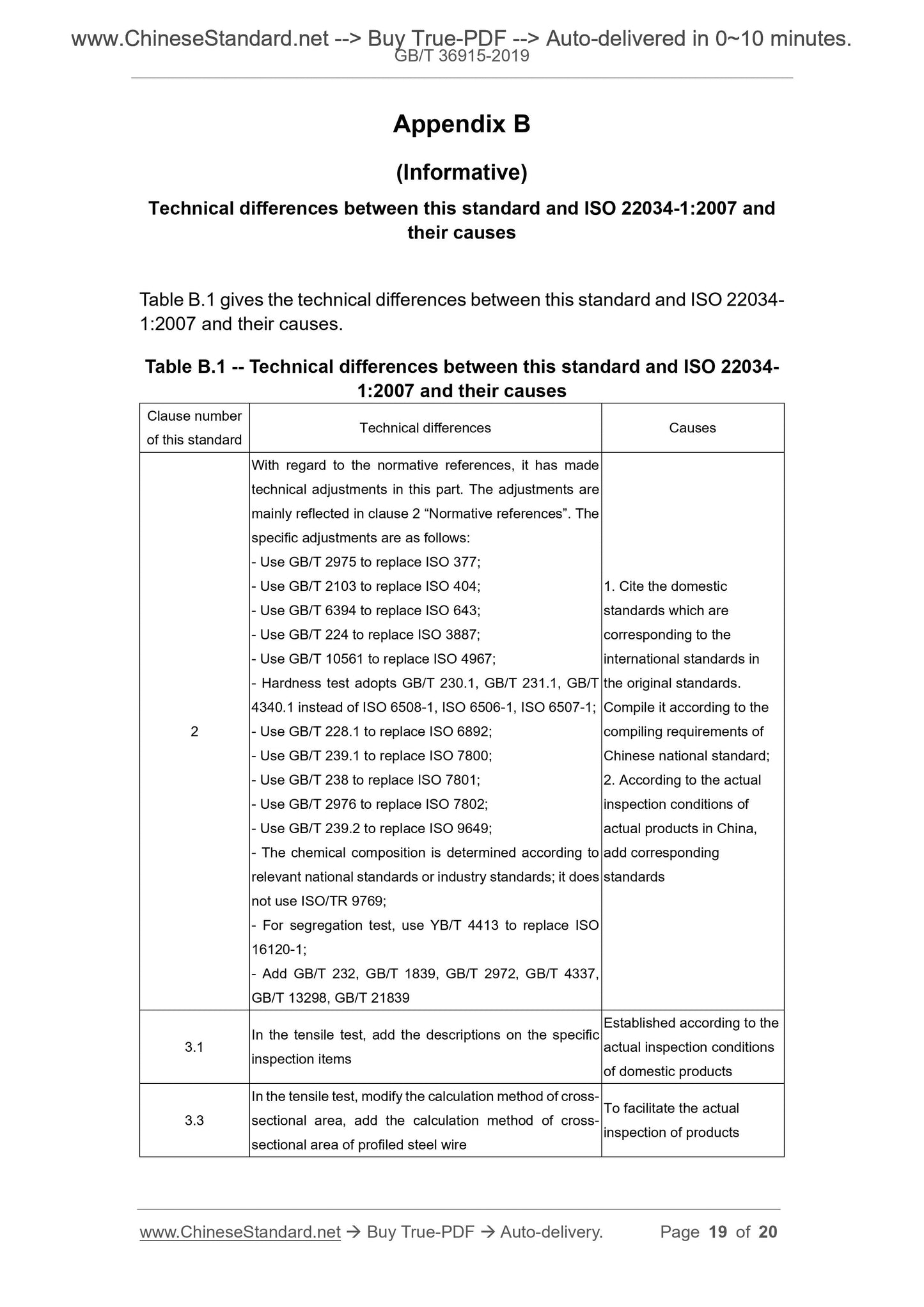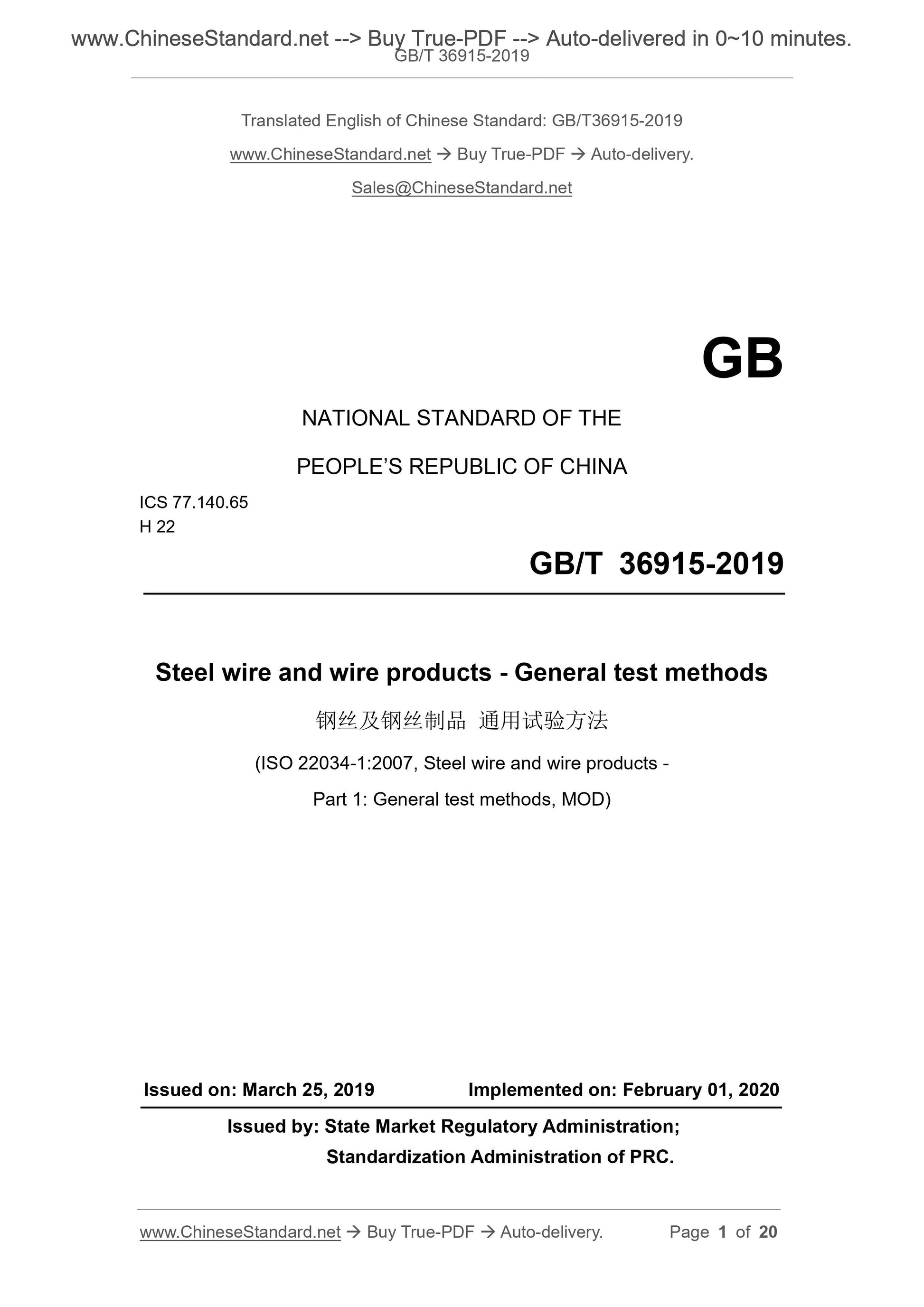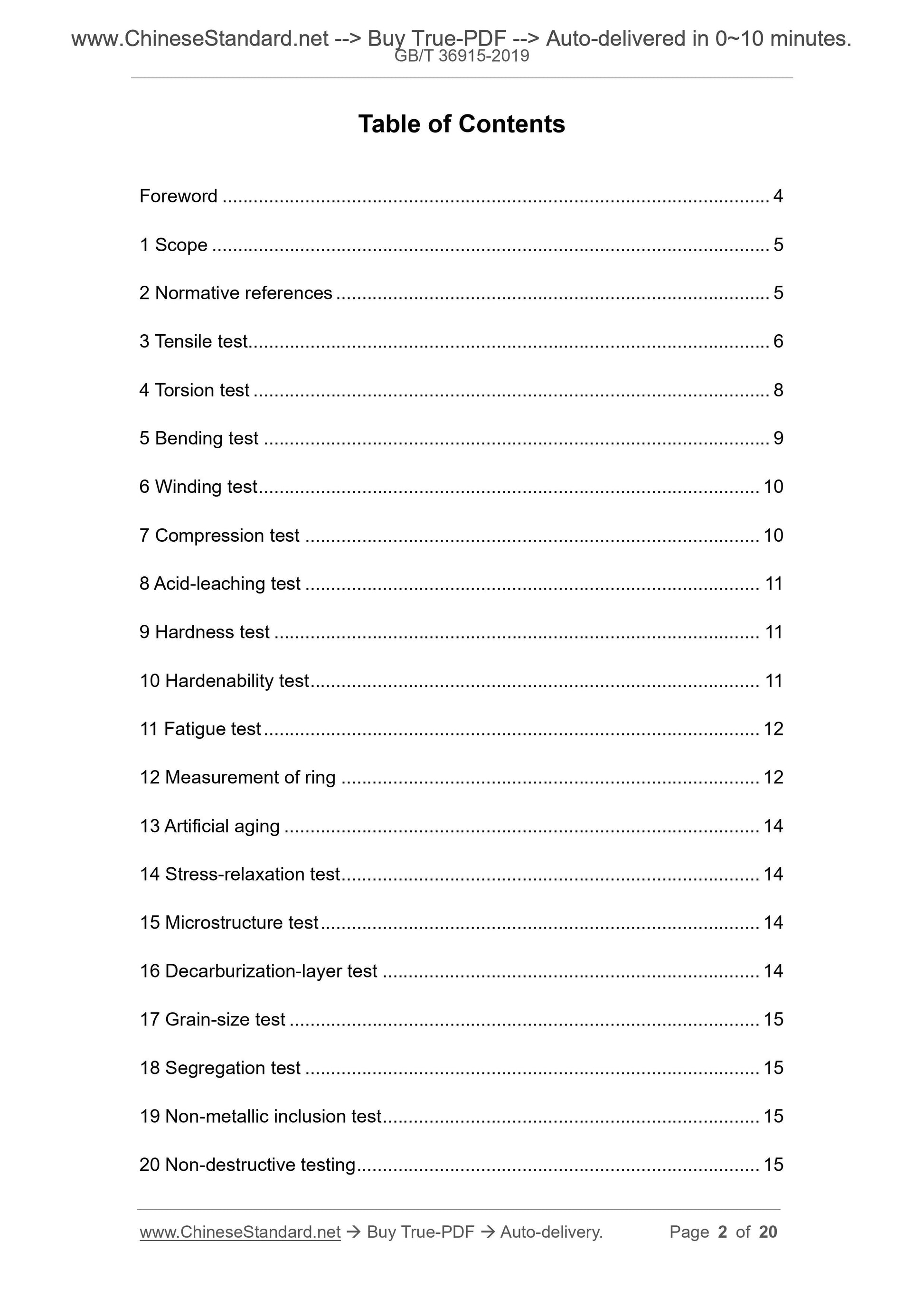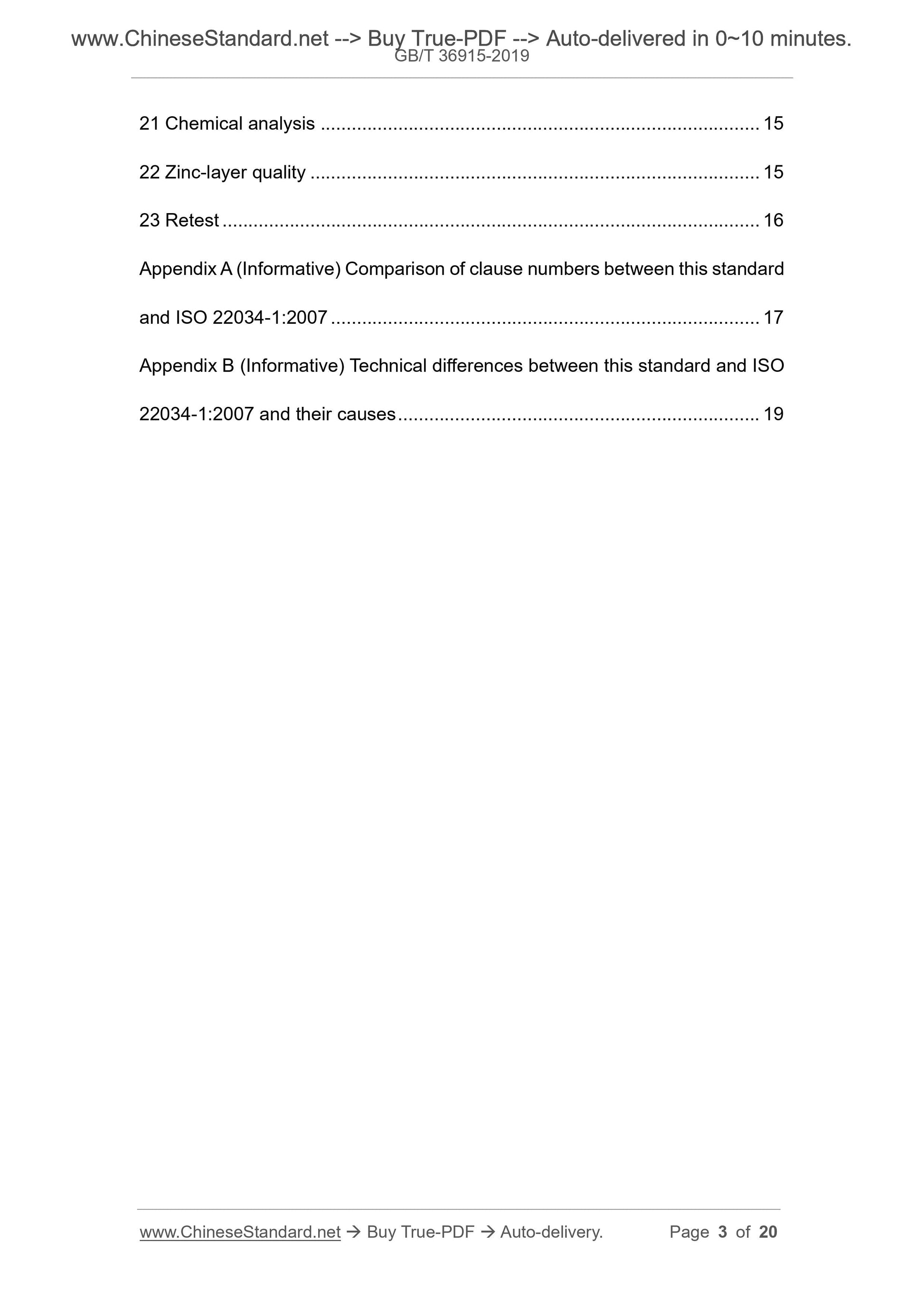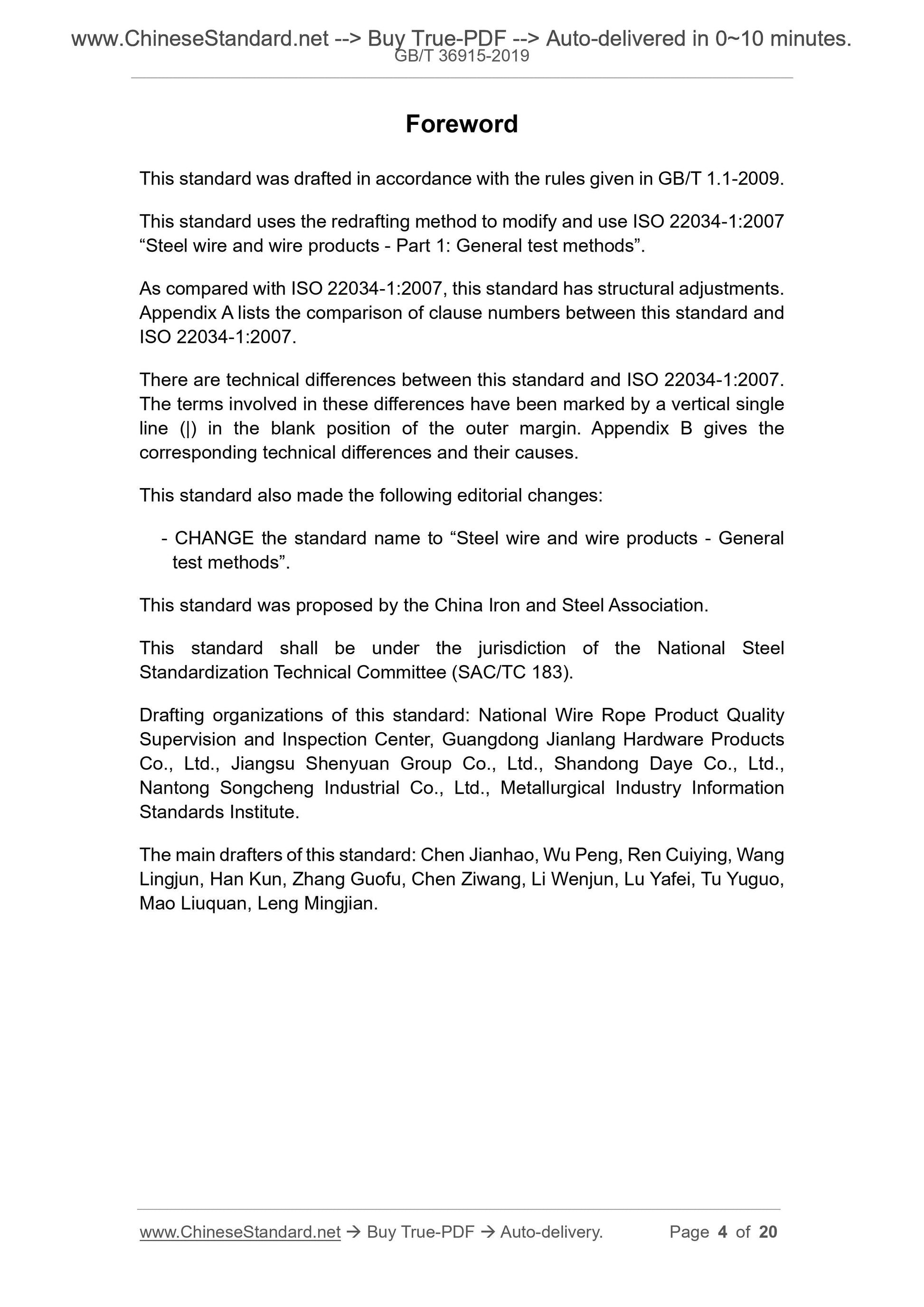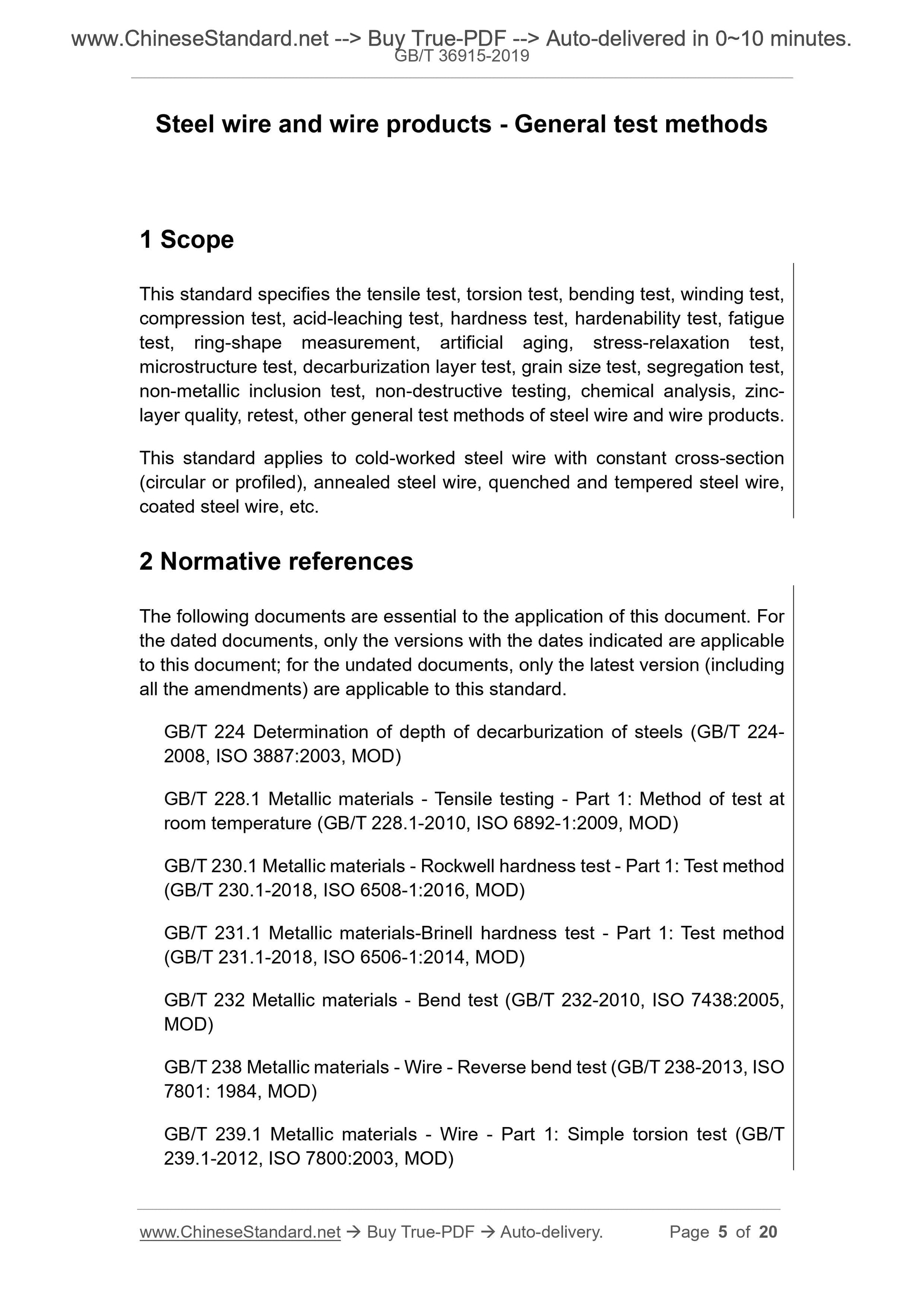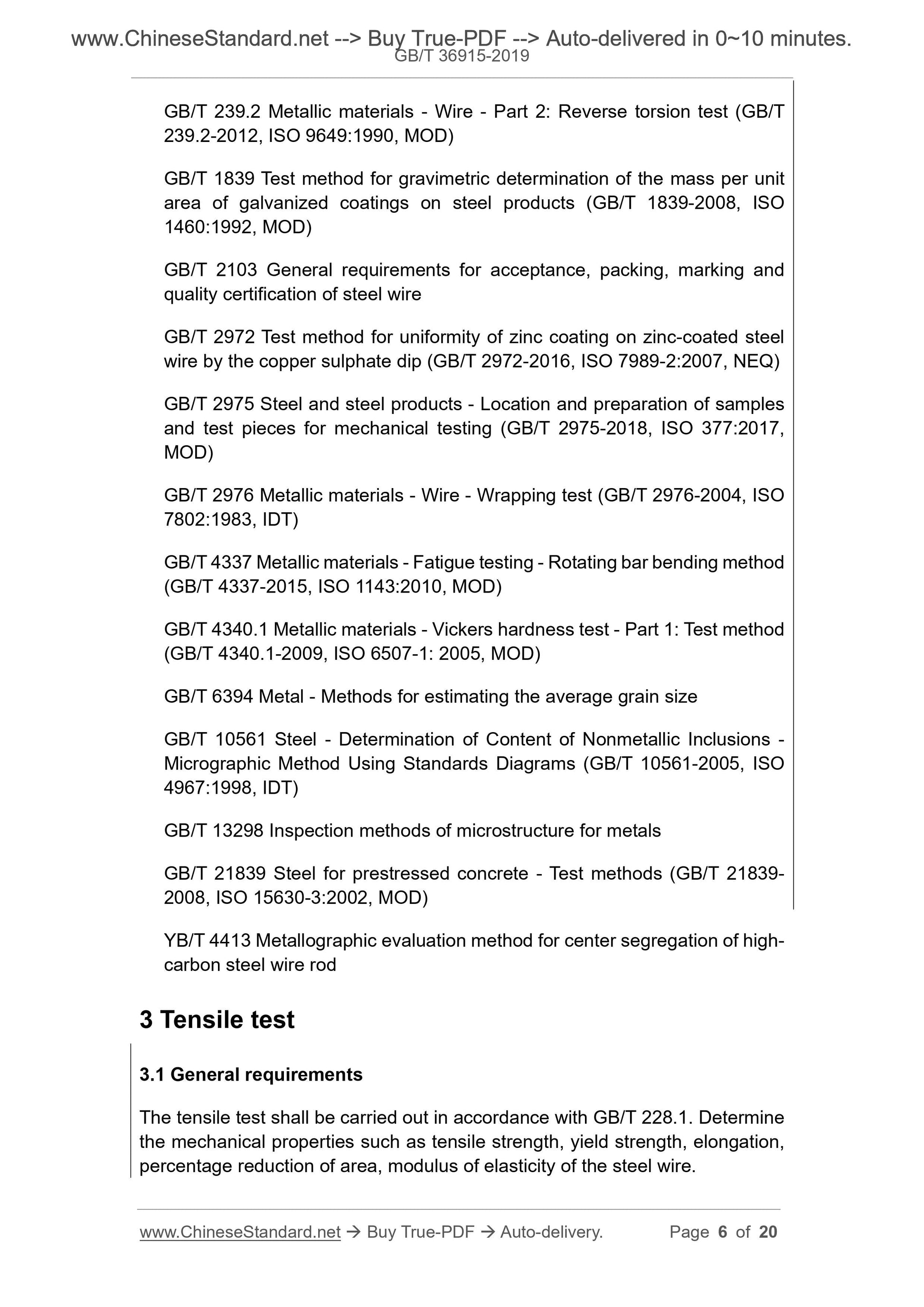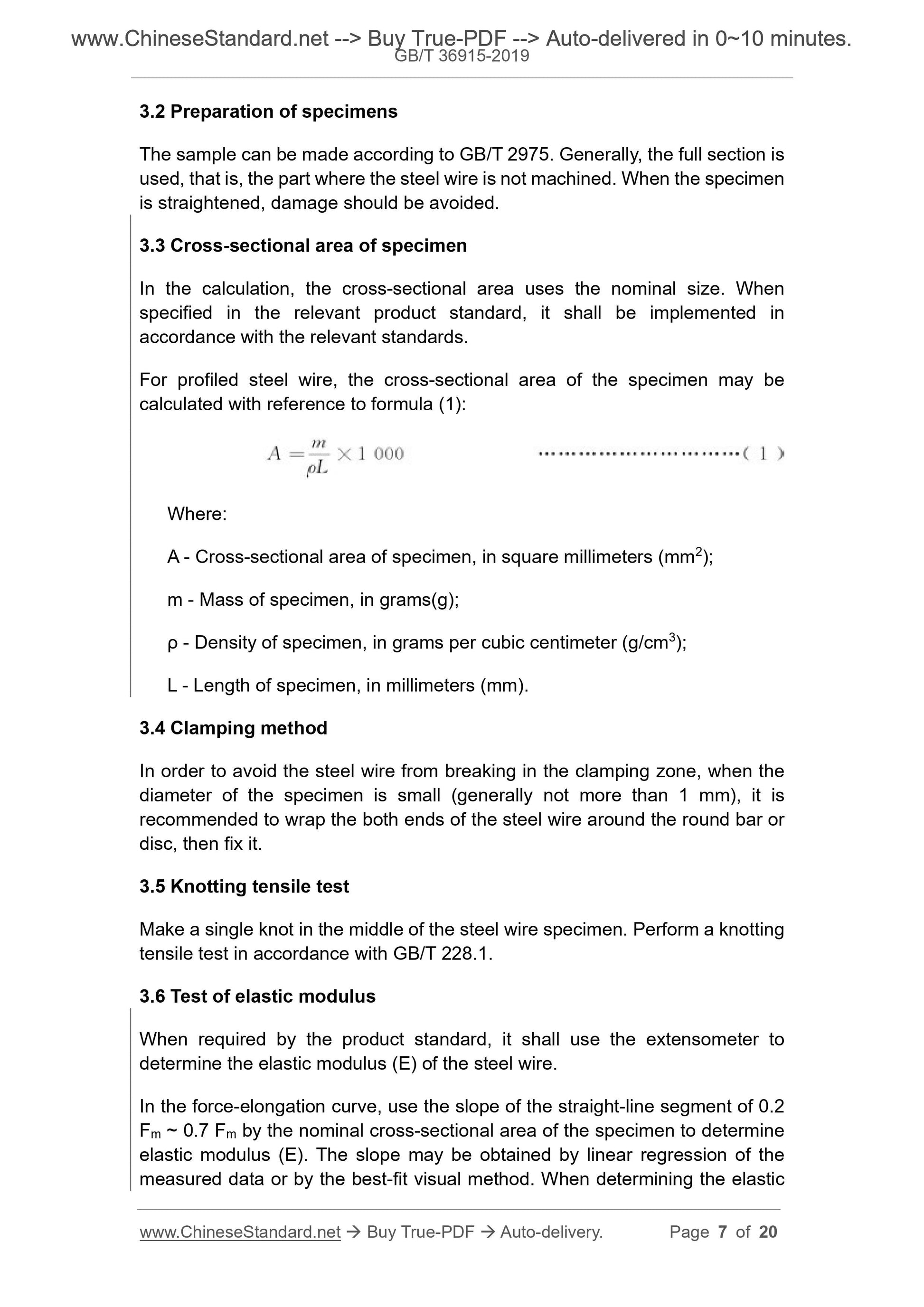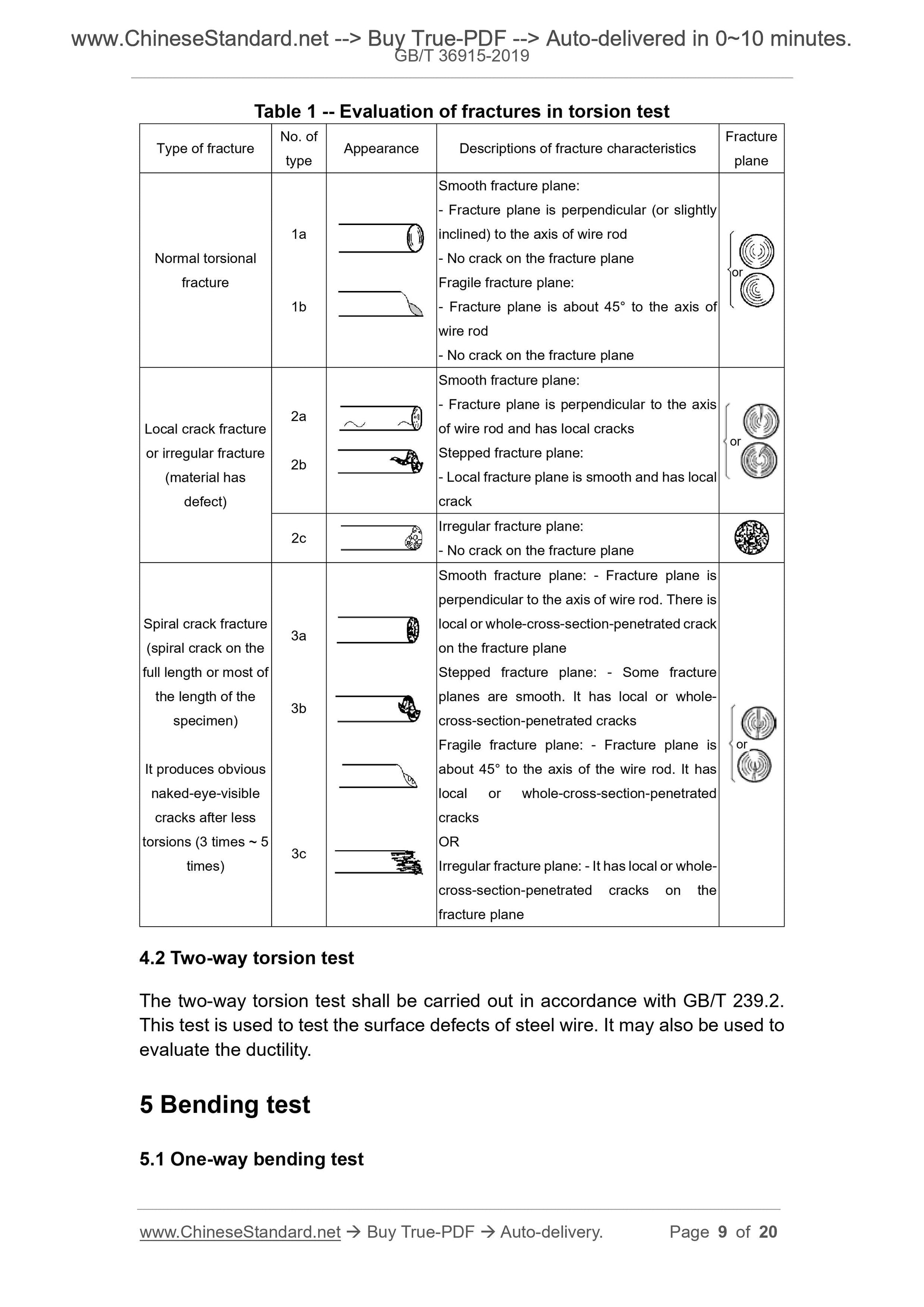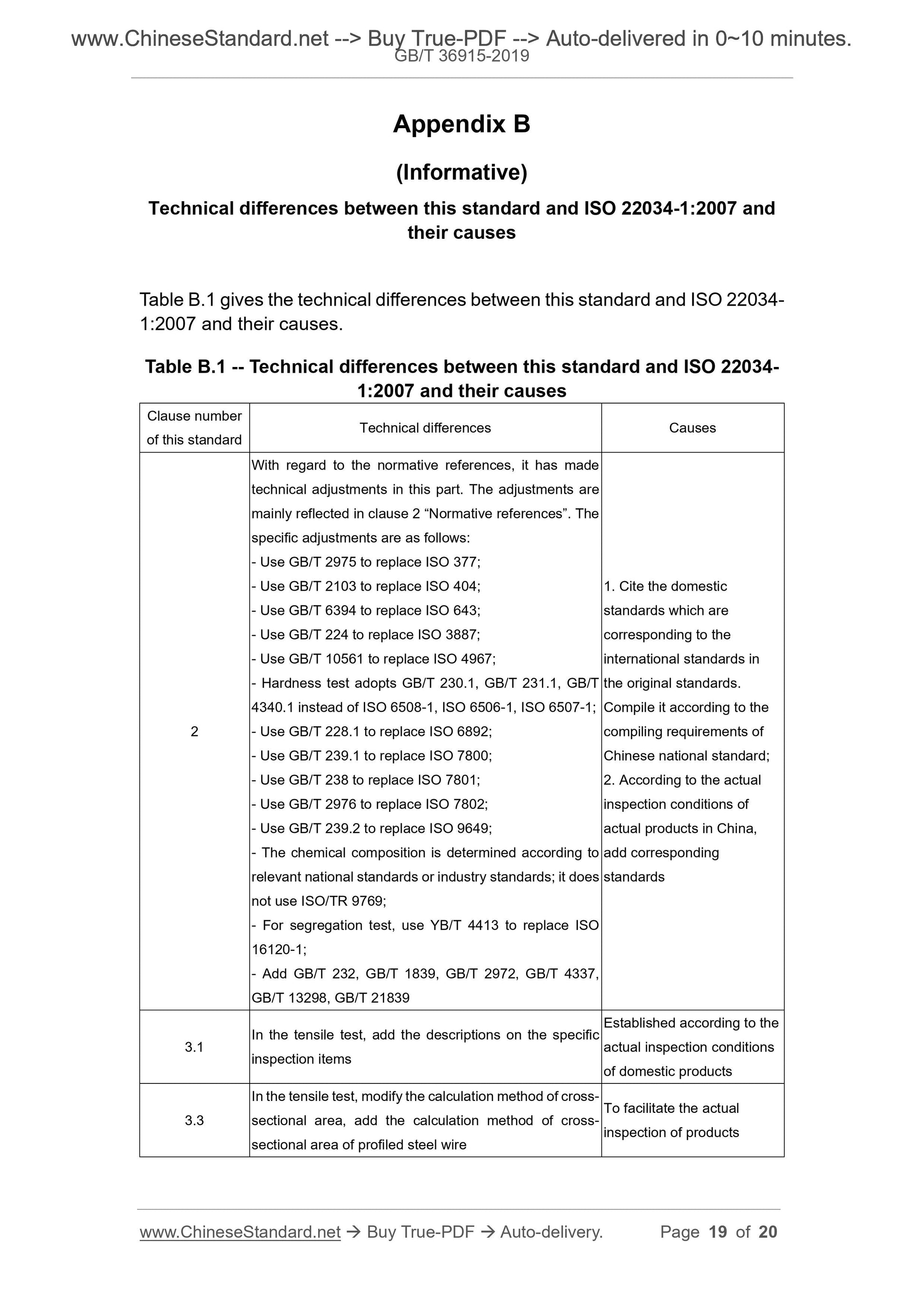1
/
of
9
www.ChineseStandard.us -- Field Test Asia Pte. Ltd.
GB/T 36915-2019 English PDF (GB/T36915-2019)
GB/T 36915-2019 English PDF (GB/T36915-2019)
Regular price
$150.00
Regular price
Sale price
$150.00
Unit price
/
per
Shipping calculated at checkout.
Couldn't load pickup availability
GB/T 36915-2019: Steel wire and wire products - General test methods
Delivery: 9 seconds. Download (& Email) true-PDF + Invoice.
Get Quotation: Click GB/T 36915-2019 (Self-service in 1-minute)
Historical versions (Master-website): GB/T 36915-2019
Preview True-PDF (Reload/Scroll-down if blank)
GB/T 36915-2019
NATIONAL STANDARD OF THE
PEOPLE’S REPUBLIC OF CHINA
ICS 77.140.65
H 22
Steel wire and wire products - General test methods
(ISO 22034-1:2007, Steel wire and wire products -
Part 1: General test methods, MOD)
ISSUED ON: MARCH 25, 2019
IMPLEMENTED ON: FEBRUARY 01, 2020
Issued by: State Market Regulatory Administration;
Standardization Administration of PRC.
Table of Contents
Foreword ... 4
1 Scope ... 5
2 Normative references ... 5
3 Tensile test ... 6
4 Torsion test ... 8
5 Bending test ... 9
6 Winding test ... 10
7 Compression test ... 10
8 Acid-leaching test ... 11
9 Hardness test ... 11
10 Hardenability test ... 11
11 Fatigue test ... 12
12 Measurement of ring ... 12
13 Artificial aging ... 14
14 Stress-relaxation test ... 14
15 Microstructure test ... 14
16 Decarburization-layer test ... 14
17 Grain-size test ... 15
18 Segregation test ... 15
19 Non-metallic inclusion test ... 15
20 Non-destructive testing ... 15
21 Chemical analysis ... 15
22 Zinc-layer quality ... 15
23 Retest ... 16
Appendix A (Informative) Comparison of clause numbers between this standard
and ISO 22034-1:2007 ... 17
Appendix B (Informative) Technical differences between this standard and ISO
22034-1:2007 and their causes ... 19
Foreword
This standard was drafted in accordance with the rules given in GB/T 1.1-2009.
This standard uses the redrafting method to modify and use ISO 22034-1:2007
“Steel wire and wire products - Part 1: General test methods”.
As compared with ISO 22034-1:2007, this standard has structural adjustments.
Appendix A lists the comparison of clause numbers between this standard and
ISO 22034-1:2007.
There are technical differences between this standard and ISO 22034-1:2007.
The terms involved in these differences have been marked by a vertical single
line (|) in the blank position of the outer margin. Appendix B gives the
corresponding technical differences and their causes.
This standard also made the following editorial changes:
- CHANGE the standard name to “Steel wire and wire products - General
test methods”.
This standard was proposed by the China Iron and Steel Association.
This standard shall be under the jurisdiction of the National Steel
Standardization Technical Committee (SAC/TC 183).
Drafting organizations of this standard: National Wire Rope Product Quality
Supervision and Inspection Center, Guangdong Jianlang Hardware Products
Co., Ltd., Jiangsu Shenyuan Group Co., Ltd., Shandong Daye Co., Ltd.,
Nantong Songcheng Industrial Co., Ltd., Metallurgical Industry Information
Standards Institute.
The main drafters of this standard: Chen Jianhao, Wu Peng, Ren Cuiying, Wang
Lingjun, Han Kun, Zhang Guofu, Chen Ziwang, Li Wenjun, Lu Yafei, Tu Yuguo,
Mao Liuquan, Leng Mingjian.
Steel wire and wire products - General test methods
1 Scope
This standard specifies the tensile test, torsion test, bending test, winding test,
compression test, acid-leaching test, hardness test, hardenability test, fatigue
test, ring-shape measurement, artificial aging, stress-relaxation test,
microstructure test, decarburization layer test, grain size test, segregation test,
non-metallic inclusion test, non-destructive testing, chemical analysis, zinc-
layer quality, retest, other general test methods of steel wire and wire products.
This standard applies to cold-worked steel wire with constant cross-section
(circular or profiled), annealed steel wire, quenched and tempered steel wire,
coated steel wire, etc.
2 Normative references
The following documents are essential to the application of this document. For
the dated documents, only the versions with the dates indicated are applicable
to this document; for the undated documents, only the latest version (including
all the amendments) are applicable to this standard.
GB/T 224 Determination of depth of decarburization of steels (GB/T 224-
2008, ISO 3887:2003, MOD)
GB/T 228.1 Metallic materials - Tensile testing - Part 1: Method of test at
room temperature (GB/T 228.1-2010, ISO 6892-1:2009, MOD)
GB/T 230.1 Metallic materials - Rockwell hardness test - Part 1: Test method
(GB/T 230.1-2018, ISO 6508-1:2016, MOD)
GB/T 231.1 Metallic materials-Brinell hardness test - Part 1: Test method
(GB/T 231.1-2018, ISO 6506-1:2014, MOD)
GB/T 232 Metallic materials - Bend test (GB/T 232-2010, ISO 7438:2005,
MOD)
GB/T 238 Metallic materials - Wire - Reverse bend test (GB/T 238-2013, ISO
7801: 1984, MOD)
GB/T 239.1 Metallic materials - Wire - Part 1: Simple torsion test (GB/T
239.1-2012, ISO 7800:2003, MOD)
GB/T 239.2 Metallic materials - Wire - Part 2: Reverse torsion test (GB/T
239.2-2012, ISO 9649:1990, MOD)
GB/T 1839 Test method for gravimetric determination of the mass per unit
area of galvanized coatings on steel products (GB/T 1839-2008, ISO
1460:1992, MOD)
GB/T 2103 General requirements for acceptance, packing, marking and
quality certification of steel wire
GB/T 2972 Test method for uniformity of zinc coating on zinc-coated steel
wire by the copper sulphate dip (GB/T 2972-2016, ISO 7989-2:2007, NEQ)
GB/T 2975 Steel and steel products - Location and preparation of samples
and test pieces for mechanical testing (GB/T 2975-2018, ISO 377:2017,
MOD)
GB/T 2976 Metallic materials - Wire - Wrapping test (GB/T 2976-2004, ISO
7802:1983, IDT)
GB/T 4337 Metallic materials - Fatigue testing - Rotating bar bending method
(GB/T 4337-2015, ISO 1143:2010, MOD)
GB/T 4340.1 Metallic materials - Vickers hardness test - Part 1: Test method
(GB/T 4340.1-2009, ISO 6507-1: 2005, MOD)
GB/T 6394 Metal - Methods for estimating the average grain size
GB/T 10561 Steel - Determination of Content of Nonmetallic Inclusions -
Micrographic Method Using Standards Diagrams (GB/T 10561-2005, ISO
4967:1998, IDT)
GB/T 13298 Inspection methods of microstructure for metals
GB/T 21839 Steel for prestressed concrete - Test methods (GB/T 21839-
2008, ISO 15630-3:2002, MOD)
YB/T 4413 Metallographic evaluation method for center segregation of high-
carbon steel wire rod
3 Tensile test
3.1 General requirements
The tensile test shall be carried out in accordance with GB/T 228.1. Determine
the mechanical properties such as tensile strength, yield strength, elongation,
percentage reduction of area, modulus of elasticity of the steel wire.
3.2 Preparation of specimens
The sample can be made according to GB/T 2975. Generally, the full section is
used, that is, the part where the steel wire is not machined. When the specimen
is straightened, damage should be avoided.
3.3 Cross-sectional area of specimen
In the calculation, the cross-sectional area uses the nominal size. When
specified in the relevant product standard, it shall be implemented in
accordance with the relevant standards.
For profiled steel wire, the cross-sectional area of the specimen may be
calculated with reference to formula (1):
Where:
A - Cross-sectional area of specimen, in square millimeters (mm2);
m - Mass of specimen, in grams(g);
ρ - Density of specimen, in grams per cubic centimeter (g/cm3);
L - Length of specimen, in millimeters (mm).
3.4 Clamping method
In order to avoid the steel wire from breaking in the clamping zone, when the
diameter of the specimen is small (generally not more than 1 mm), it is
recommended to wrap the both ends of the steel wire around the round bar or
disc, then fix it.
3.5 Knotting tensile test
Make a single knot in the middle of the steel wire specimen. Perform a knotting
tensile test in accordance with GB/T 228.1.
3.6 Test of elastic modulus
When required by the product standard, it shall use the extensometer to
determine the elastic modulus (E) of the steel wire.
In the force-elongation curve, use the slope of the straight-line segment of 0.2
Fm ~ 0.7 Fm by the nominal cross-sectional area of the specimen to determine
elastic modulus (E). The slope may be obtained by linear regression of the
measured data or by the best-fit visual method. When determining the elastic
Table 1 -- Evaluation of fractures in torsion test
Type of fracture No. of type Appearance Descriptions of fracture characteristics
Fracture
plane
Normal torsional
fracture
1a
1b
Smooth fracture plane:
- Fracture plane is perpendicular (or slightly
inclined) to the axis of wire rod
- No crack on the fracture plane
Fragile fracture plane:
- Fracture plane is about 45° to the axis of
wire rod
- No crack on the fracture plane
Local crack fracture
or irregular fracture
(material has
defect)
2a
2b
Smooth fracture plane:
- Fracture plane is perpendicular to the axis
of wire rod and has local cracks
Stepped fracture plane:
- Local fracture plane is smooth and has local
crack
2c
Irregular fracture plane:
- No crack on the fracture plane
Spiral crack fracture
(spiral crack on the
full length or most of
the length of the
specimen)
It produces obvious
naked-eye-visible
cracks after less
torsions (3 times ~ 5
times)
3a
3b
3c
Smooth fracture plane: - Fracture plane is
perpendicular to the axis of wire rod. There is
local or whole-cross-section-penetrated crack
on the fracture plane
Stepped fracture plane: - Some fracture
planes are smooth. It has local or whole-
cross-section-penetrated cracks
Fragile fracture plane: - Fracture plane is
about 45° to the axis of the wire rod. It has
local or whole-cross-section-penetrated
cracks
OR
Irregular fracture plane: - It has local or whole-
cross-section-penetrated cracks on the
fracture plane
4.2 Two-way torsion test
The two-way torsion test shall be carried out in accordance with GB/T 239.2.
This test is used to test the surface defects of steel wire. It may also be used to
evaluate the ductility.
5 Bending test
5.1 One-way bending test
or
or
or
Appendix B
(Informative)
Technical differences between this standard and ISO 22034-1:2007 and
their causes
Table B.1 gives the technical differences between this standard and ISO 22034-
1:2007 and their causes.
Table B.1 -- Technical differences between this standard and ISO 22034-
1:2007 and their causes
Clause number
of this standard Technical differences Causes
With regard to the normative references, it has made
technical adjustments in this part. The adjustments are
mainly reflected in clause 2 “Normative references”. The
specific adjustments are as follows:
- Use GB/T 2975 to replace ISO 377;
- Use GB/T 2103 to replace ISO 404;
- Use GB/T 6394 to replace ISO 643;
- Use GB/T 224 to replace ISO 3887;
- Use GB/T 10561 to replace ISO 4967;
- Hardness test adopts GB/T 230.1, GB/T 231.1, GB/T
4340.1 instead of ISO 6508-1, ISO 6506-1, ISO 6507-1;
- Use GB/T 228.1 to replace ISO 6892;
- Use GB/T 239.1 to replace ISO 7800;
- Use GB/T 238 to replace ISO 7801;
- Use GB/T 2976 to replace ISO 7802;
- Use GB/T 239.2 to replace ISO 9649;
- The chemical composition is determined according to
relevant national standards or industry standards; it does
not use ISO/TR 9769;
- For segregation test, use YB/T 4413 to replace ISO
16120-1;
- Add GB/T 232, GB/T 1839, GB/T 2972, GB/T 4337,
GB/T 13298, GB/T 21839
1. Cite the domestic
standards which are
corresponding to the
international standards in
the original standards.
Compile it according to the
compiling requirements of
Chinese national standard;
2. According to the actual
inspection conditions of
actual products in China,
add corresponding
standards
3.1 In the tensile test, add the descriptions on the specific inspection items
Established according to the
actual inspection conditions
of domestic products
3.3
In the tensile test, modify the calculation method of cross-
sectional area, add the calculation method of cross-
sectional area of profiled steel wire
To facilitate the actual
inspection of products
GB/T 36915-2019
NATIONAL STANDARD OF THE
PEOPLE’S REPUBLIC OF CHINA
ICS 77.140.65
H 22
Steel wire and wire products - General test methods
(ISO 22034-1:2007, Steel wire and wire products -
Part 1: General test methods, MOD)
ISSUED ON: MARCH 25, 2019
IMPLEMENTED ON: FEBRUARY 01, 2020
Issued by: State Market Regulatory Administration;
Standardization Administration of PRC.
Table of Contents
Foreword ... 4
1 Scope ... 5
2 Normative references ... 5
3 Tensile test ... 6
4 Torsion test ... 8
5 Bending test ... 9
6 Winding test ... 10
7 Compression test ... 10
8 Acid-leaching test ... 11
9 Hardness test ... 11
10 Hardenability test ... 11
11 Fatigue test ... 12
12 Measurement of ring ... 12
13 Artificial aging ... 14
14 Stress-relaxation test ... 14
15 Microstructure test ... 14
16 Decarburization-layer test ... 14
17 Grain-size test ... 15
18 Segregation test ... 15
19 Non-metallic inclusion test ... 15
20 Non-destructive testing ... 15
21 Chemical analysis ... 15
22 Zinc-layer quality ... 15
23 Retest ... 16
Appendix A (Informative) Comparison of clause numbers between this standard
and ISO 22034-1:2007 ... 17
Appendix B (Informative) Technical differences between this standard and ISO
22034-1:2007 and their causes ... 19
Foreword
This standard was drafted in accordance with the rules given in GB/T 1.1-2009.
This standard uses the redrafting method to modify and use ISO 22034-1:2007
“Steel wire and wire products - Part 1: General test methods”.
As compared with ISO 22034-1:2007, this standard has structural adjustments.
Appendix A lists the comparison of clause numbers between this standard and
ISO 22034-1:2007.
There are technical differences between this standard and ISO 22034-1:2007.
The t...
Delivery: 9 seconds. Download (& Email) true-PDF + Invoice.
Get Quotation: Click GB/T 36915-2019 (Self-service in 1-minute)
Historical versions (Master-website): GB/T 36915-2019
Preview True-PDF (Reload/Scroll-down if blank)
GB/T 36915-2019
NATIONAL STANDARD OF THE
PEOPLE’S REPUBLIC OF CHINA
ICS 77.140.65
H 22
Steel wire and wire products - General test methods
(ISO 22034-1:2007, Steel wire and wire products -
Part 1: General test methods, MOD)
ISSUED ON: MARCH 25, 2019
IMPLEMENTED ON: FEBRUARY 01, 2020
Issued by: State Market Regulatory Administration;
Standardization Administration of PRC.
Table of Contents
Foreword ... 4
1 Scope ... 5
2 Normative references ... 5
3 Tensile test ... 6
4 Torsion test ... 8
5 Bending test ... 9
6 Winding test ... 10
7 Compression test ... 10
8 Acid-leaching test ... 11
9 Hardness test ... 11
10 Hardenability test ... 11
11 Fatigue test ... 12
12 Measurement of ring ... 12
13 Artificial aging ... 14
14 Stress-relaxation test ... 14
15 Microstructure test ... 14
16 Decarburization-layer test ... 14
17 Grain-size test ... 15
18 Segregation test ... 15
19 Non-metallic inclusion test ... 15
20 Non-destructive testing ... 15
21 Chemical analysis ... 15
22 Zinc-layer quality ... 15
23 Retest ... 16
Appendix A (Informative) Comparison of clause numbers between this standard
and ISO 22034-1:2007 ... 17
Appendix B (Informative) Technical differences between this standard and ISO
22034-1:2007 and their causes ... 19
Foreword
This standard was drafted in accordance with the rules given in GB/T 1.1-2009.
This standard uses the redrafting method to modify and use ISO 22034-1:2007
“Steel wire and wire products - Part 1: General test methods”.
As compared with ISO 22034-1:2007, this standard has structural adjustments.
Appendix A lists the comparison of clause numbers between this standard and
ISO 22034-1:2007.
There are technical differences between this standard and ISO 22034-1:2007.
The terms involved in these differences have been marked by a vertical single
line (|) in the blank position of the outer margin. Appendix B gives the
corresponding technical differences and their causes.
This standard also made the following editorial changes:
- CHANGE the standard name to “Steel wire and wire products - General
test methods”.
This standard was proposed by the China Iron and Steel Association.
This standard shall be under the jurisdiction of the National Steel
Standardization Technical Committee (SAC/TC 183).
Drafting organizations of this standard: National Wire Rope Product Quality
Supervision and Inspection Center, Guangdong Jianlang Hardware Products
Co., Ltd., Jiangsu Shenyuan Group Co., Ltd., Shandong Daye Co., Ltd.,
Nantong Songcheng Industrial Co., Ltd., Metallurgical Industry Information
Standards Institute.
The main drafters of this standard: Chen Jianhao, Wu Peng, Ren Cuiying, Wang
Lingjun, Han Kun, Zhang Guofu, Chen Ziwang, Li Wenjun, Lu Yafei, Tu Yuguo,
Mao Liuquan, Leng Mingjian.
Steel wire and wire products - General test methods
1 Scope
This standard specifies the tensile test, torsion test, bending test, winding test,
compression test, acid-leaching test, hardness test, hardenability test, fatigue
test, ring-shape measurement, artificial aging, stress-relaxation test,
microstructure test, decarburization layer test, grain size test, segregation test,
non-metallic inclusion test, non-destructive testing, chemical analysis, zinc-
layer quality, retest, other general test methods of steel wire and wire products.
This standard applies to cold-worked steel wire with constant cross-section
(circular or profiled), annealed steel wire, quenched and tempered steel wire,
coated steel wire, etc.
2 Normative references
The following documents are essential to the application of this document. For
the dated documents, only the versions with the dates indicated are applicable
to this document; for the undated documents, only the latest version (including
all the amendments) are applicable to this standard.
GB/T 224 Determination of depth of decarburization of steels (GB/T 224-
2008, ISO 3887:2003, MOD)
GB/T 228.1 Metallic materials - Tensile testing - Part 1: Method of test at
room temperature (GB/T 228.1-2010, ISO 6892-1:2009, MOD)
GB/T 230.1 Metallic materials - Rockwell hardness test - Part 1: Test method
(GB/T 230.1-2018, ISO 6508-1:2016, MOD)
GB/T 231.1 Metallic materials-Brinell hardness test - Part 1: Test method
(GB/T 231.1-2018, ISO 6506-1:2014, MOD)
GB/T 232 Metallic materials - Bend test (GB/T 232-2010, ISO 7438:2005,
MOD)
GB/T 238 Metallic materials - Wire - Reverse bend test (GB/T 238-2013, ISO
7801: 1984, MOD)
GB/T 239.1 Metallic materials - Wire - Part 1: Simple torsion test (GB/T
239.1-2012, ISO 7800:2003, MOD)
GB/T 239.2 Metallic materials - Wire - Part 2: Reverse torsion test (GB/T
239.2-2012, ISO 9649:1990, MOD)
GB/T 1839 Test method for gravimetric determination of the mass per unit
area of galvanized coatings on steel products (GB/T 1839-2008, ISO
1460:1992, MOD)
GB/T 2103 General requirements for acceptance, packing, marking and
quality certification of steel wire
GB/T 2972 Test method for uniformity of zinc coating on zinc-coated steel
wire by the copper sulphate dip (GB/T 2972-2016, ISO 7989-2:2007, NEQ)
GB/T 2975 Steel and steel products - Location and preparation of samples
and test pieces for mechanical testing (GB/T 2975-2018, ISO 377:2017,
MOD)
GB/T 2976 Metallic materials - Wire - Wrapping test (GB/T 2976-2004, ISO
7802:1983, IDT)
GB/T 4337 Metallic materials - Fatigue testing - Rotating bar bending method
(GB/T 4337-2015, ISO 1143:2010, MOD)
GB/T 4340.1 Metallic materials - Vickers hardness test - Part 1: Test method
(GB/T 4340.1-2009, ISO 6507-1: 2005, MOD)
GB/T 6394 Metal - Methods for estimating the average grain size
GB/T 10561 Steel - Determination of Content of Nonmetallic Inclusions -
Micrographic Method Using Standards Diagrams (GB/T 10561-2005, ISO
4967:1998, IDT)
GB/T 13298 Inspection methods of microstructure for metals
GB/T 21839 Steel for prestressed concrete - Test methods (GB/T 21839-
2008, ISO 15630-3:2002, MOD)
YB/T 4413 Metallographic evaluation method for center segregation of high-
carbon steel wire rod
3 Tensile test
3.1 General requirements
The tensile test shall be carried out in accordance with GB/T 228.1. Determine
the mechanical properties such as tensile strength, yield strength, elongation,
percentage reduction of area, modulus of elasticity of the steel wire.
3.2 Preparation of specimens
The sample can be made according to GB/T 2975. Generally, the full section is
used, that is, the part where the steel wire is not machined. When the specimen
is straightened, damage should be avoided.
3.3 Cross-sectional area of specimen
In the calculation, the cross-sectional area uses the nominal size. When
specified in the relevant product standard, it shall be implemented in
accordance with the relevant standards.
For profiled steel wire, the cross-sectional area of the specimen may be
calculated with reference to formula (1):
Where:
A - Cross-sectional area of specimen, in square millimeters (mm2);
m - Mass of specimen, in grams(g);
ρ - Density of specimen, in grams per cubic centimeter (g/cm3);
L - Length of specimen, in millimeters (mm).
3.4 Clamping method
In order to avoid the steel wire from breaking in the clamping zone, when the
diameter of the specimen is small (generally not more than 1 mm), it is
recommended to wrap the both ends of the steel wire around the round bar or
disc, then fix it.
3.5 Knotting tensile test
Make a single knot in the middle of the steel wire specimen. Perform a knotting
tensile test in accordance with GB/T 228.1.
3.6 Test of elastic modulus
When required by the product standard, it shall use the extensometer to
determine the elastic modulus (E) of the steel wire.
In the force-elongation curve, use the slope of the straight-line segment of 0.2
Fm ~ 0.7 Fm by the nominal cross-sectional area of the specimen to determine
elastic modulus (E). The slope may be obtained by linear regression of the
measured data or by the best-fit visual method. When determining the elastic
Table 1 -- Evaluation of fractures in torsion test
Type of fracture No. of type Appearance Descriptions of fracture characteristics
Fracture
plane
Normal torsional
fracture
1a
1b
Smooth fracture plane:
- Fracture plane is perpendicular (or slightly
inclined) to the axis of wire rod
- No crack on the fracture plane
Fragile fracture plane:
- Fracture plane is about 45° to the axis of
wire rod
- No crack on the fracture plane
Local crack fracture
or irregular fracture
(material has
defect)
2a
2b
Smooth fracture plane:
- Fracture plane is perpendicular to the axis
of wire rod and has local cracks
Stepped fracture plane:
- Local fracture plane is smooth and has local
crack
2c
Irregular fracture plane:
- No crack on the fracture plane
Spiral crack fracture
(spiral crack on the
full length or most of
the length of the
specimen)
It produces obvious
naked-eye-visible
cracks after less
torsions (3 times ~ 5
times)
3a
3b
3c
Smooth fracture plane: - Fracture plane is
perpendicular to the axis of wire rod. There is
local or whole-cross-section-penetrated crack
on the fracture plane
Stepped fracture plane: - Some fracture
planes are smooth. It has local or whole-
cross-section-penetrated cracks
Fragile fracture plane: - Fracture plane is
about 45° to the axis of the wire rod. It has
local or whole-cross-section-penetrated
cracks
OR
Irregular fracture plane: - It has local or whole-
cross-section-penetrated cracks on the
fracture plane
4.2 Two-way torsion test
The two-way torsion test shall be carried out in accordance with GB/T 239.2.
This test is used to test the surface defects of steel wire. It may also be used to
evaluate the ductility.
5 Bending test
5.1 One-way bending test
or
or
or
Appendix B
(Informative)
Technical differences between this standard and ISO 22034-1:2007 and
their causes
Table B.1 gives the technical differences between this standard and ISO 22034-
1:2007 and their causes.
Table B.1 -- Technical differences between this standard and ISO 22034-
1:2007 and their causes
Clause number
of this standard Technical differences Causes
With regard to the normative references, it has made
technical adjustments in this part. The adjustments are
mainly reflected in clause 2 “Normative references”. The
specific adjustments are as follows:
- Use GB/T 2975 to replace ISO 377;
- Use GB/T 2103 to replace ISO 404;
- Use GB/T 6394 to replace ISO 643;
- Use GB/T 224 to replace ISO 3887;
- Use GB/T 10561 to replace ISO 4967;
- Hardness test adopts GB/T 230.1, GB/T 231.1, GB/T
4340.1 instead of ISO 6508-1, ISO 6506-1, ISO 6507-1;
- Use GB/T 228.1 to replace ISO 6892;
- Use GB/T 239.1 to replace ISO 7800;
- Use GB/T 238 to replace ISO 7801;
- Use GB/T 2976 to replace ISO 7802;
- Use GB/T 239.2 to replace ISO 9649;
- The chemical composition is determined according to
relevant national standards or industry standards; it does
not use ISO/TR 9769;
- For segregation test, use YB/T 4413 to replace ISO
16120-1;
- Add GB/T 232, GB/T 1839, GB/T 2972, GB/T 4337,
GB/T 13298, GB/T 21839
1. Cite the domestic
standards which are
corresponding to the
international standards in
the original standards.
Compile it according to the
compiling requirements of
Chinese national standard;
2. According to the actual
inspection conditions of
actual products in China,
add corresponding
standards
3.1 In the tensile test, add the descriptions on the specific inspection items
Established according to the
actual inspection conditions
of domestic products
3.3
In the tensile test, modify the calculation method of cross-
sectional area, add the calculation method of cross-
sectional area of profiled steel wire
To facilitate the actual
inspection of products
GB/T 36915-2019
NATIONAL STANDARD OF THE
PEOPLE’S REPUBLIC OF CHINA
ICS 77.140.65
H 22
Steel wire and wire products - General test methods
(ISO 22034-1:2007, Steel wire and wire products -
Part 1: General test methods, MOD)
ISSUED ON: MARCH 25, 2019
IMPLEMENTED ON: FEBRUARY 01, 2020
Issued by: State Market Regulatory Administration;
Standardization Administration of PRC.
Table of Contents
Foreword ... 4
1 Scope ... 5
2 Normative references ... 5
3 Tensile test ... 6
4 Torsion test ... 8
5 Bending test ... 9
6 Winding test ... 10
7 Compression test ... 10
8 Acid-leaching test ... 11
9 Hardness test ... 11
10 Hardenability test ... 11
11 Fatigue test ... 12
12 Measurement of ring ... 12
13 Artificial aging ... 14
14 Stress-relaxation test ... 14
15 Microstructure test ... 14
16 Decarburization-layer test ... 14
17 Grain-size test ... 15
18 Segregation test ... 15
19 Non-metallic inclusion test ... 15
20 Non-destructive testing ... 15
21 Chemical analysis ... 15
22 Zinc-layer quality ... 15
23 Retest ... 16
Appendix A (Informative) Comparison of clause numbers between this standard
and ISO 22034-1:2007 ... 17
Appendix B (Informative) Technical differences between this standard and ISO
22034-1:2007 and their causes ... 19
Foreword
This standard was drafted in accordance with the rules given in GB/T 1.1-2009.
This standard uses the redrafting method to modify and use ISO 22034-1:2007
“Steel wire and wire products - Part 1: General test methods”.
As compared with ISO 22034-1:2007, this standard has structural adjustments.
Appendix A lists the comparison of clause numbers between this standard and
ISO 22034-1:2007.
There are technical differences between this standard and ISO 22034-1:2007.
The t...
Share
